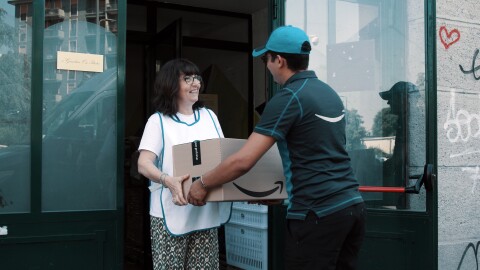In between sessions about how the cloud is accelerating innovation for businesses of all kinds, summit attendees had the opportunity to help the Humanitarian OpenStreetMap Team (HOT) - an AWS customer - improve program planning for refugee communities.
How? Representatives from HOT, and AWS, invited visitors to swipe through satellite images on an app called MapSwipe. Every time they saw an identifiable feature - such as a building, or a road - all they had to do was tap the image.
Far from the kind of mindless scrolling so many of us associate with smartphones, this ‘crowd-sourced’ mapping is of real help to HOT, and other organizations like it.
Anyone with a smartphone or tablet can carry out basic infrastructure identification work in their free time, without needing to travel anywhere. It helps build the first layer of a map of a specific area in OpenStreetMap - a collaborative project to create a free, detailed map of the world.
Through this growing global community of open mapping volunteers, HOT can create maps of any area, especially those at risk of natural disasters, such as hurricanes, floods or earthquakes. This allows teams on the ground to work together with local communities to add local details, such as the names of buildings and roads, which help humanitarian organizations better assist those in need.
For those working with refugees or other vulnerable groups, having an accurate, up-to-date map of an area helps people to navigate in places where the environment may have been altered by natural disasters, or conflict, and is necessary for effective resource, and service, provision.

OpenStreetMap allows places to be tagged in multiple languages, and with multiple names - a vital feature when you have lots of groups of people speaking different languages, or using different local or cultural names to refer to the same place.
The Brussels Summit is not the first place AWS has run a volunteer exercise with HOT. AWS employees in the United States have taken part in company-organised ‘mapathons’ to support disaster response efforts following the devastating flooding in Kerala, India in 2018, and a recent outbreak of Ebola along the border of Uganda and the Democratic Republic of Congo.
While these activities add value to HOT’s work, and give time-strapped but enthusiastic people the opportunity to engage in meaningful volunteering, there’s a lot more AWS wants to do. Through its AWS Disaster Response Program, the company is thinking big about how to deploy its technology, and services, to support coordinated responses to disaster situations.
Launched in 2018, the program’s overarching goal is to use the power of the cloud to help governments, non-profits, and other institutions, better prepare for, and respond to, disasters. This could range from floods to earthquakes, disease outbreaks, and beyond.
Jed Sundwall, who leads the AWS Open Data team, and is based in Munich, spoke to an audience at the Brussels Summit about how his work feeds into the program.
“We have a piece of hardware called a Snowball Edge,” he said. “It’s a tough, portable server that can withstand extreme conditions. We can turn it into an offline catalogue of aerial imagery, a processing tool, and a data-sharing device.
“Let’s say there’s been an earthquake in a remote location, with no connectivity. We can train teams to deploy a Snowball Edge loaded with imagery of the region to the site where relief organisations are working. Organisations can then access very high-quality satellite images, taken before the disaster, and send out drones to capture new ones, which the Snowball Edge can quickly process.
“Responders can use the images taken before the disaster to identify the main population centres. By comparing these with images taken after the disaster, they can identify the hardest-hit areas, and target resources there.”
“One advantage of setting up the AWS Disaster Response Program is that it allows us to focus on preparedness,” he continued. “Having data already in the cloud means you’re not scrambling for it in an emergency.”
Jed was careful to emphasise that AWS will never test anything new in a disaster. “We don’t want to add noise to challenging situations,” he said.
In the United States, where the program began, there is a growing Disaster Response Action Team of employees with high skill sets in specific technological, and other areas, who have volunteered to be deployed in emergencies.
“We are always going to look at how what we can offer can be adapted to the needs of different scenarios,” says Maggie Carter, who runs the program out of Washington D.C.
“We work with customers, partners, and a network of relief organisations, such as HOT, and the American Red Cross, to determine how best we can help in each case. This year we aim to expand our activities in Europe, the Middle East, Africa, and Japan.”
If you work for a humanitarian or international development organisation with operations in Europe, Middle East or Africa (EMEA), and would be interested in potentially partnering with the AWS Disaster Response Program, you can contact the team at Aws-drp@amazon.com.
The AWS Public Sector Summit took place in Brussels on 9th April. It is one of a number of AWS summits taking place this year.
Visit the AWS Global Summit programme for more information about events in your region: https://aws.amazon.com/events/summits/












